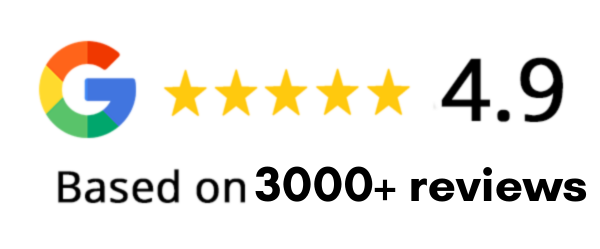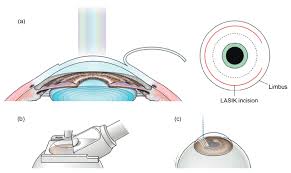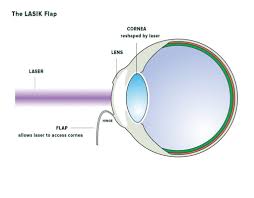Table of Contents
ToggleThe brain’s ability to adapt following LASIK vision correction lies in a phenomenon called cortical plasticity.
This is how neural circuits in the brain reorganise themselves to process improved visual information generated by the eyes after corrective surgery.
Curious about how this works? Let’s explore the fascinating interplay between LASIK, the visual cortex, and the brain’s incredible capability to adapt and rewire itself.
What is Cortical Plasticity?
Cortical plasticity refers to the brain’s extraordinary ability to change its structure and function in response to new experiences or altered sensory inputs. This adaptability ensures that humans can recover (to a degree) from various sensory and neurological disruptions.
When it comes to vision, the brain plays an instrumental role, as sight is not just about the eyes but also how the brain interprets what the eyes see. For instance, when vision is corrected through LASIK surgery, the brain’s visual cortex must adapt to a clearer, more precise visual input. This process exemplifies cortical plasticity.
Why Does Cortical Plasticity Matter for Vision?
Even minor changes in the quality of visual input can trigger the brain to adjust its neural pathways. LASIK surgery significantly alters the visual input by reshaping the cornea to correct common refractive errors like myopia (nearsightedness), hyperopia (farsightedness), and astigmatism.
After LASIK, your retina receives sharper images, and your brain needs to process these enhanced visuals. Cortical plasticity is what helps the brain recalibrate itself, ensuring seamless integration of this improved sensory information. Without this adaptability, even perfect vision correction wouldn’t translate into a clear visual experience.
LASIK Surgery and Its Impact on the Visual System
To fully appreciate how the brain rewires itself after LASIK, it’s crucial to understand how the procedure changes the optical mechanics of the eye.
The Goal of LASIK Surgery
LASIK reshapes the cornea, the front transparent layer of the eye, to focus light onto the retina more accurately. By doing so, it essentially removes visual distortions, such as blurry or double vision, caused by refractive errors.
Immediate Visual Changes Post-LASIK
When LASIK is completed, many patients report significant visual improvement within the first 24 hours. However, during this period, the brain begins its adaptive work. It must learn to process the newly corrected visual signals while overcoming reliance on any pre-operative compensations, like enlarged objects or partial clarity patterns.
How the Brain Rewires Itself Post-LASIK?
When the brain receives altered visual input after LASIK, the visual cortex, located in the occipital lobe, goes through a phase of reorganisation. This rewiring involves strengthening certain neural connections and discarding older, less useful pathways.
Sensory Recalibration
The clearer and sharper vision provided by LASIK presents new data to the brain that it hasn’t processed before. Neurons in the visual cortex must adapt to interpret this higher-quality input. This often involves recalibrating the brain’s understanding of depth, contrast, shapes, and motion.
One fascinating aspect here is how the brain processes corrected vision in individuals who may have had refractive errors for years—even decades. Old habits such as squinting or relying on partial clarity cues often need to be “unlearned”.
Neural Plasticity and Visual Rehabilitation
Several studies have shown that neural plasticity post-LASIK is strongest in the first few months after surgery. The brain actively modifies its processing centres to adapt to sharper images and new focal points. This phase is critical for achieving optimum long-term vision quality.
Patients might initially notice challenges such as halos around lights or difficulty adjusting to dim environments. These experiences are the result of incomplete cortical adaptation, which tends to improve as the brain fine-tunes itself.
Scientific Evidence Supporting Cortical Plasticity Post-LASIK
The concept of the brain’s adaptability post-LASIK is backed by robust scientific evidence.
Changes in the Visual Cortex
Functional MRI (fMRI) scans have shown that after LASIK surgery, there is increased activation in the visual cortex. This suggests the brain is actively processing and reorganising its neural pathways to accommodate enhanced vision clarity.
Patients with longstanding refractive errors often exhibit the most significant neural adaptations because their brains must overcome ingrained visual compensations.
Research on Neural Efficiency
Studies have indicated that the efficiency of neural signals in the visual pathways improves post-LASIK. Essentially, this means the brain uses less energy to process information because the corrected vision requires fewer compensatory mechanisms.
For example, patients who previously relied on stronger cues for recognising shapes or motion tend to show reduced reliance on these secondary cues.
Factors Influencing the Brain’s Rewiring Post-LASIK
Not every patient experiences the same cortical plasticity adjustments following LASIK. Factors such as age, duration of refractive error, and overall brain health play a role in how quickly and efficiently the brain adapts to improved vision.
1. Age
While cortical plasticity is present throughout life, younger individuals often experience faster neural adaptation due to heightened neuroplasticity.
2. Duration of Visual Impairment
Patients who’ve lived with severe vision impairments for an extended period might require more time for cortical rewiring, as their brains are accustomed to compensatory mechanisms.
3. Consistency in Brain Stimulation
Engaging in activities that rely heavily on visual inputs, such as reading or playing visually complex games, can accelerate cortical adjustments.
Implications for Patients and LASIK Candidates
Understanding cortical plasticity’s role in LASIK outcomes can help both patients and medical professionals set realistic expectations for recovery and results.
Initial Adaptation Period
Patients should know that while LASIK provides near-immediate improvements, the brain’s adaptation might take weeks or even months. Temporary visual anomalies, like light sensitivity or difficulty with night vision, are often part of this adjustment process.
Role of Consistent Visual Habits
Experts recommend performing activities that strengthen visual focus, such as solving puzzles or mindful observation exercises, to facilitate faster neural adaptation.
Long-Term Visual Improvements
Research shows that patients typically reach peak vision performance within six months post-LASIK, once the brain has fully reorganised its neural pathways around the enhanced visual input.
Beyond LASIK: Cortical Plasticity in Vision Science
The concept of cortical plasticity extends beyond LASIK. It underpins advancements in other vision correction methods, such as corneal transplants or advanced contact lenses. Neuroscientists are also leveraging this phenomenon to develop solutions for visual impairments that were previously thought to be untreatable.
This deeper understanding of neural adaptability is crucial not only for enhancing surgical outcomes but also for addressing conditions like amblyopia and post-stroke visual deficits.
The Future of LASIK and Cortical Adaptation
With continued progress in LASIK technology, including enhanced laser precision and AI-guided diagnostics, the post-operative outcomes are likely to become even better. Such advancements will also push neuroscientific research further, offering clearer insights into how the visual cortex adapts to changing sensory environments.
Ultimately, LASIK doesn’t just transform how you see the world – it transforms how your brain sees it too.













